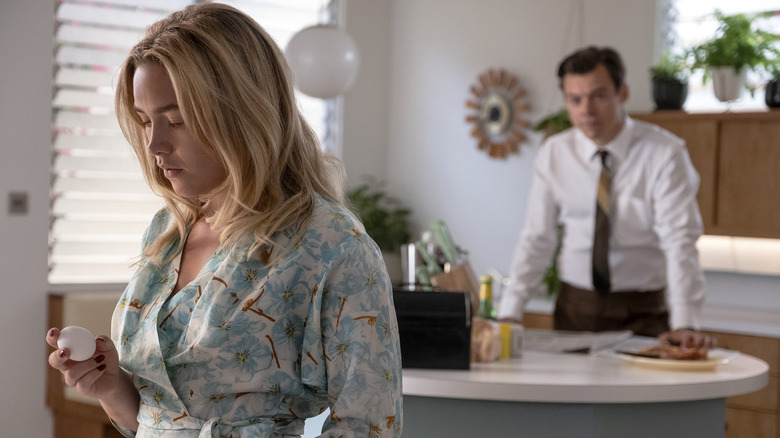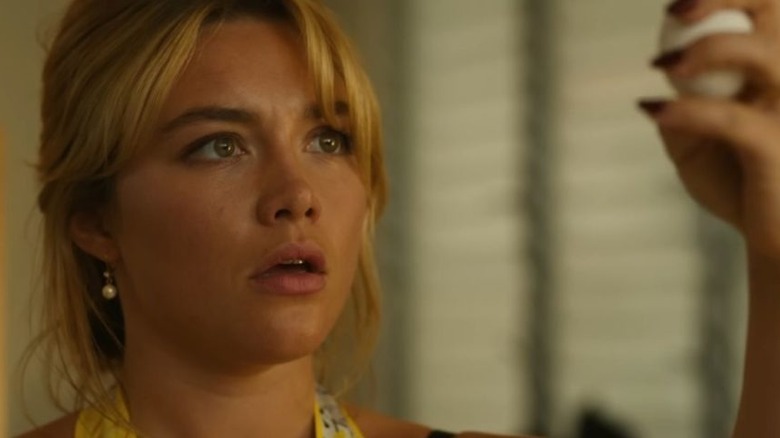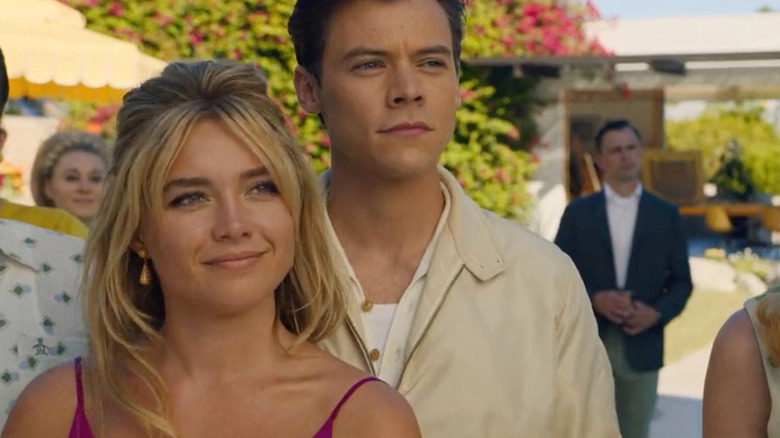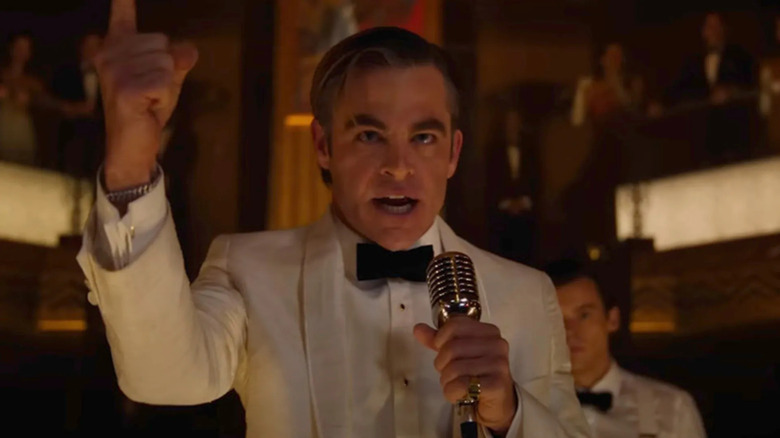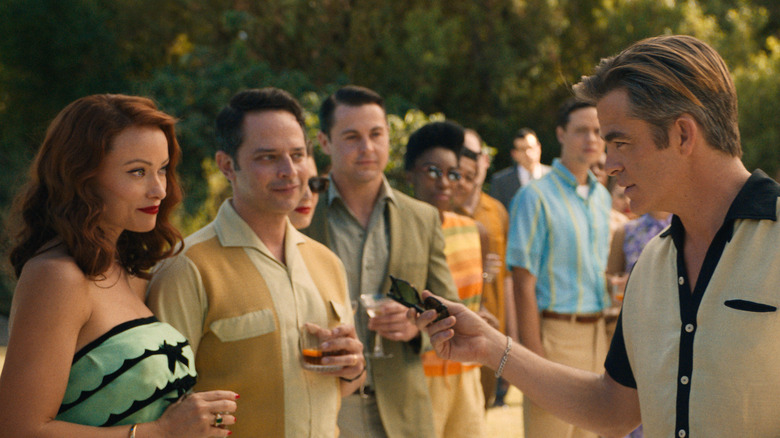Don't Worry Darling Ending Explained: Go Ask, Alice
Human beings have a natural resistance to change. Every time anything in someone's life is thrown off course, from their daily routine to their preconceived notions about the world, people find themselves either adjusting or resisting.The numerous instances of anti-progressive thought that can be seen in society today (especially that coming from cisgendered white men) are proof positive of this continual phenomenon, and thus the arts — being the bastion of cultural commentary that they are — react accordingly.
Olivia Wilde's second feature as a director, "Don't Worry Darling," is the latest in an increasingly large wave of socially conscious horror and genre pictures. While some of the pitfalls of this trend can certainly be seen in the film (a putting of the metaphorical cart before the character and plot horse, for instance), its themes of feminism and misogyny combined with its surprisingly compelling ambiguity makes it a more fascinating experience than its tabloid-style press tour would indicate.
The trailers for "Don't Worry Darling" promise a big twist to come within the film's narrative, and Wilde (along with writer Katie Silberman, working from a story by herself and Casey and Shane Van Dyke) make no bones about the fact that nothing in the film is what it seems early on.
Through the looking (Google) glass
Set sometime during the 1950s, the movie follows Alice Chambers (Florence Pugh), a model housewife to her husband Jack (Harry Styles). The Chambers' are very much in love, and live in suburban bliss within the secluded desert community of Victory. While Jack and the rest of the town's men head off in their shiny Cadillacs every morning to go work at the mysterious, top-secret Victory project run by Frank (Chris Pine), Alice and the wives head into town to shop, lounge by the pool, and learn ballet from Frank's wife Shelley (Gemma Chan). Either that, or they stay home and clean the house before preparing dinner, getting rewarded with a house party or two every so often.
Despite this carefree existence that reinforces patriarchal norms and traditional gender roles, Alice begins having strange visions that cause her to start questioning the nature of her reality. Add to that a triggering event — the suicide of fellow housewife Margaret (KiKi Layne), who was apparently the first to realize Victory was hiding something — and Alice is in full Rosemary Woodhouse mode (or should that be Joanna Eberhart mode?), venturing out to the Victory headquarters building where the women are forbidden and challenging Frank to reveal what's really going on.
What's really going on is that Victory isn't a real place, but rather a total virtual simulation. It's not the '50s, it's actually 2022, and the Victory simulation is the creation of Frank and possibly Dr. Collins (Timothy Simons), who lure discontented men into joining this virtual cult where the women are present against their will. Alice, a doctor in the real world married to an unemployed Jack, breaks her brainwashing and murders Jack in self-defense, an act that helps to wake up most of the other women. Making a break for the Victory headquarters (which is actually a portal that allows people in the simulation to wake up in the real world), Alice defeats her pursuers and frees herself from Victory.
Same as it ever was
It's hard to say whether "Don't Worry Darling" is derivative on purpose or by accident, but there's no denying that its plot is highly predictable given the sheer number of films that like to pull the rug of reality from under the audience (not to mention the protagonist).
There are, frankly, too many to namecheck, but the closest examples are the aforementioned "Rosemary's Baby" and "The Stepford Wives," both of which were based on books by Ira Levin. Those films reflect the contemporary existence of second-wave feminism, which was not only a progression from the first-wave but was reacting to the heavily chauvinist norms of the '50s and '60s. In these films, as in "Don't Worry Darling," the female protagonists find themselves forced into a gender role and lifestyle against their will, the women not realizing they've been trapped until it's almost too late.
"Don't Worry Darling" also applies the last 20-odd years of genre filmmaking to its story, becoming a mish-mash of false reality narratives. Its stew includes the anachronistic twist of M. Night Shyamalan's "The Village," the placating simulations of "The Matrix" and "Serenity," the technophobia of "Black Mirror" and "Westworld," and the social commentary aims of "Get Out."
The white picket fence
The most potent aspect of "Don't Worry Darling" lies in its 1950s trappings, literally and figuratively. Cinematographer Matthew Libatique, production designer Katie Byron and costume designer Arianne Phillips make the Victory simulation look so picture perfect and idealized that Wilde hardly has to add much in the way of blood or empty eggshells to indicate that there's something wrong with the environment. The film is so meticulously constructed on a visual level that even the slightest deviation registers.
In terms of American history, the 1950s are an endlessly fertile period to subvert and satirize; even while the decade was occurring, filmmakers like Alfred Hitchcock and Don Siegel had an inkling that the white picket fence gloss of the era was hiding something disturbing beneath. That subtext became more overt text a few decades later, as the works of directors like David Lynch and films like "Pleasantville" pointed out the disconnect between the cultural image of the '50s and its repression and oppressiveness underneath.
Make America fake again
Given its virtual simulation twist, "Don't Worry Darling" also belongs to a tradition of stories about false utopias — not just films and books but video games. The insidiously fascist Art Deco iconography of Victory recalls the Randian false utopia of the game "Bioshock," as does the cult leader-cum-philosophical guru demeanor of Frank, who's analogous to the game's Andrew Ryan.
Of course, Wilde and Silberman clearly want Frank to emulate a real-life pundit and proponent of so-called "Men's Rights," the odious Jordan Peterson. Peterson and Frank's shared opinion that straight men have lost the cultural power they once held is the dark crux of the movie, with Victory not-so-subtly being a place where Frank and those who feel the same can make their lives "great" again. Of course, the fact that Victory is not only a lie but a recreation of a world that was never quite so "great" is lost on them, just as it's lost on fools like Peterson.
Et tu, Bunny?
Wilde and Silberman make sure "Don't Worry Darling" leans heavily into ambiguity, which (by design or by accident) helps make the ending that much more intriguing. While the film's themes are made perfectly clear, its ultimate message is broader and more layered than it may seem on first glance.
The most intriguing choice made in the film may or may not have been wholly intentional. The character of Bunny is revealed to have known what Victory really was right from the start, and has been complacent with Frank and the others so that she may get to have her children back, her kids having died in the real world. This choice obviously speaks to the phenomenon of anti-feminism in women as well as expands the villainy of the film beyond mere misogyny.
Yet there's a fascinating extra wrinkle to the character: Bunny is, of course, played by Wilde herself. While this may be the director intentionally muddying the metaphorical waters or the actress simply choosing a plum role for herself, it also indicates that Victory may not be a fictional paradise for men only.
Victory for whom?
With that in mind, there's a curious exceptionalism that can be seen in Alice's journey. To wit, she's a beautiful young woman with a gorgeous and desirable husband (with whom she has frequent and very cunnilingus-heavy sex), she has all her faculties about her (enough that she's only one of two people to discover the truth about Victory) and, in the film's last act, becomes a car chase heroine who soundly defeats her enemies.
Wilde keeps utilizing shots of women dancing in an homage to classic Busby Berkeley musical numbers of the '30s, '40s and '50s. This recurring imagery seems to be critiquing the way women have been used in film as fantasy objects since the dawn of the medium — but is that fantasy only a one-way street for the male gaze? The audience is never given the catharsis of seeing Alice wake up in the "real world" having escaped Victory — we only know that she has escaped. Is Wilde intimating that such an escape is only a fantasy for most women? Or that the entire film may have been Alice's fantasy, a way for her to take the power back, as it were, by railing against a real-life oppressive patriarchal society and culture that is far more difficult to dismantle?
As the movie's title suggests, the true enemy may be apathetic complacency, and all "Don't Worry Darling" seeks to do is stir the pot of such apathy. Whether we choose to worry or not is up to us.
